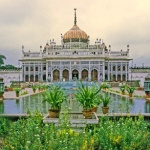Traditions Lucknow, India
 At 18 and 19. in the Muslim Lucknow formed a striking variety of music and dance forms, which to this day stand out among the performing arts of northern India. This period is considered the "Golden Age" culture of India.
At 18 and 19. in the Muslim Lucknow formed a striking variety of music and dance forms, which to this day stand out among the performing arts of northern India. This period is considered the "Golden Age" culture of India.In addition to the musicians of the court and just court, among whom were some of nawabs themselves in the cultural life of the city played an important role tavayf (courtesan), which became skilled poets, dancers and singers.
At that time, as the foundation of classical music styles were dhrupad and Khai, a high level of development reached thumri - lyrical songs in the style of blending classical ragas and folk tunes, and became widely popular forms such as Dadra, Tapp, and Hori, formed under the influence folk traditions. They are called "semiclassical" or "light" classical music.
Kathak (Kathak) - the main genre of north Indian classical dance, evolved during the reign of nawabs as Shuja-ud-Daula (1756 - 75 years.) And Asaf-ud-Daula (1775 - 97 years.). R Krishna frolicking with the girls-thrush has become especially popular in the plot representations; technically Kathak is based on strong and energetic movements of the legs, complex rhythmic compositions, accompanied by playing the tabla - a pair of drums.
Fectival Lucknow, which takes place in February, gives visitors an excellent opportunity to get acquainted with samples of urban living traditions of music and dance.